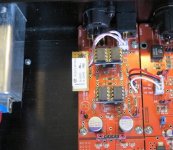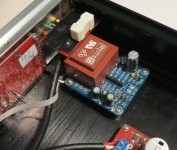Hi Erlend,
- This will make people disappointed.
We are a few who need to realize this scheme of connections. Quanghao / Andrea had responded positively.Erlend Sæterdal said:Well that is easy : just do not do that.
- This will make people disappointed.
Hi Quanghao & Andrea,
I have been asking to you the schematic of the I/V output stage for several times and you did never answered me on that point.
So, following the traces on the PCB, I tried to recognize how are connected the output connectors XLR and RCA. I think it looks like the joined schematic and I consider this schematic is a little bit simplistic... This means that it is impossible to use at the same time the XLR connector to sub amp and RCA connector to main amp because we will encounter issues in impedance balance.
More, I notice that + and - are not "summed" on RCA output.
- Do you confirm my point of view ?
Thank you very much.
I don't have the complete schematic at this time but as I told before you can use both outputs.
The XLR and RCA are in parallel so for the "impedance balance" the RCA load should be 10 times higher than XLR load.
The op-amp output impedance is very low so you will not ear differences also if there is a un-balanced impedance on XLR.
Hi Andrea,
So, according to this schematic, if I need two unbalanced non parallel outputs, can I consider that :
- The output "+" remains connected to the RCA connector.
- The output "-" is connected through the XLR to a second RCA connector.
The consequence being that these two unbalanced RCA output are opposite in phase.
audiodesign said:I don't have the complete schematic at this time but as I told before you can use both outputs.
The XLR and RCA are in parallel so for the "impedance balance" the RCA load should be 10 times higher than XLR load.
The op-amp output impedance is very low so you will not ear differences also if there is a un-balanced impedance on XLR.
So, according to this schematic, if I need two unbalanced non parallel outputs, can I consider that :
- The output "+" remains connected to the RCA connector.
- The output "-" is connected through the XLR to a second RCA connector.
The consequence being that these two unbalanced RCA output are opposite in phase.
Last edited:
Hi,
To prevent loud pops in the loudspeakers, my DAC is now fitted with a mute on XLR and RCA outputs :
- A reused and modified protection circuit for loudspeakers controls one relay per channel that connects the outputs to ground during power up or during power down the DAC.
To prevent loud pops in the loudspeakers, my DAC is now fitted with a mute on XLR and RCA outputs :
- A reused and modified protection circuit for loudspeakers controls one relay per channel that connects the outputs to ground during power up or during power down the DAC.
Attachments
Hm why do not you just do as normal people. Turn on the amp at last and turn it off at first ?
- Because, as perhaps many of us (normal or notHm why do not you just do as normal people. Turn on the amp at last and turn it off at first ?
 ), I turn on or turn off all the components of my system at the same time with only one general switch.
), I turn on or turn off all the components of my system at the same time with only one general switch.- Because, as perhaps many of us (normal or not), I turn on or turn off all the components of my system at the same time with only one general switch.
it is not good for hi-end audio!
turn on and turn off the audio system should comply with the principle, you should not switch to a system for all.
thanks
Hi Quanghao,
I have been doing that way for more than thirty years and I have never never encountered any problem. I precise that, like most of professional and high-end equipements, all the components of my audio system are fitted with mute on turn on/off.
- This is the other easy way of using high-end audio for normal people 😉.
it is not good for hi-end audio!
turn on and turn off the audio system should comply with the principle, you should not switch to a system for all.thanks
I have been doing that way for more than thirty years and I have never never encountered any problem. I precise that, like most of professional and high-end equipements, all the components of my audio system are fitted with mute on turn on/off.
- This is the other easy way of using high-end audio for normal people 😉.
Last edited:
Hi Quanghao,
- This is the other easy way of using high-end audio for normal people 😉.
yes!
Thanks
Quanghao,
I've sent my remaining payment (425$, shipping fedex). Pls confirm & check your PM for the details & address. Pls send the DAC after 12 August as I will be away until 18 August.
Do not forget to declare it as gift & lower value to avoid custom fee 🙂
Many thanks,
rachmanto
I've sent my remaining payment (425$, shipping fedex). Pls confirm & check your PM for the details & address. Pls send the DAC after 12 August as I will be away until 18 August.
Do not forget to declare it as gift & lower value to avoid custom fee 🙂
Many thanks,
rachmanto
Hello,it is not good for hi-end audio!
turn on and turn off the audio system should comply with the principle, you should not switch to a system for all.
thanks
I agree with Domi-78 , general on/off is suitable when you have much audio devices.
Moreover , if you have valve amplifiers , a temporisation for High Voltage is used and all components have time for temperature stability.
Br
Jacky
Domi-78 : it seems we are the only french guys in this post , if you agree could we exchange our email address ?
Guys,
I'm expecting the delivery of my DAC. Do you mind sharing what are the opamps (beside OPA627 & 2134) you have tested with the output stage & your impression ? I plan to use it with LM4562 as I have some already.
I'm expecting the delivery of my DAC. Do you mind sharing what are the opamps (beside OPA627 & 2134) you have tested with the output stage & your impression ? I plan to use it with LM4562 as I have some already.
Hi Jacky,
MP sent.
- No, we are at least three french guys : the third one is Raoul (rlyiung) which is a friend of mine living near Toulouse. We are members of Mélaudia (forum)kmajjo said:Domi-78 : it seems we are the only french guys in this post , if you agree could we exchange our email address ?
MP sent.
Last edited:
I have some concerns on the discrete output stage:
- does it support single-ended output?
- could you integrate LME49600 headphone buffer into it? Or just design and leave the trace/jumper on the PCB for us to solder LME49600 ourself if we need it? I foresee that I may use DAC to drive quality headphone quite often in future. I prefer LME49600 over BUF634.
National LME49600 Audio Buffer
- does it support single-ended output?
- could you integrate LME49600 headphone buffer into it? Or just design and leave the trace/jumper on the PCB for us to solder LME49600 ourself if we need it? I foresee that I may use DAC to drive quality headphone quite often in future. I prefer LME49600 over BUF634.
National LME49600 Audio Buffer
Hello Quanghao, I am still waiting an answer for my message (16 of July) about discrete output with a delay for delivery
By the way, Domi78, I am living in Brest so we are at least 4 Frenchs
By the way, Domi78, I am living in Brest so we are at least 4 Frenchs
Sent DAC complete
Today I sent DAC complete for you below:
A. TNT Tracking:
1/Andrea: 759 514 680
2/Masterkey: 759 514 676
3/Myfavoritettthing: 75,905,140,645
4/NicMac: 75,905,140,659
5/Matmax: 759 514 662
B. Fedex Tracking:
1/gjorgji: 8034 8573 6354
Please check the goods under the bill of lading number above.
Thank you very much.
Today I sent DAC complete for you below:
A. TNT Tracking:
1/Andrea: 759 514 680
2/Masterkey: 759 514 676
3/Myfavoritettthing: 75,905,140,645
4/NicMac: 75,905,140,659
5/Matmax: 759 514 662
B. Fedex Tracking:
1/gjorgji: 8034 8573 6354
Please check the goods under the bill of lading number above.
Thank you very much.
- Status
- Not open for further replies.
- Home
- More Vendors...
- Quanghao Audio Design
- DAC-END R (ES9018) full assembled board

